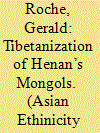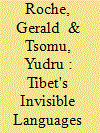| Srl | Item |
| 1 |
ID:
143676


|
|
|
|
|
| Summary/Abstract |
The Sino-Tibetan frontier is typically portrayed as a large, complex, and diverse transitional region between Tibetan and Chinese cultural realms. The concept of Tibetanization is often deployed to classify the ethnically ambiguous ‘interstitial’ populations of this area. This article critically examines the concept of Tibetanization through a study of the Mongols of Henan County, Qinghai Province, a population repeatedly described as Tibetanized. A survey of local folkways reveals that Henan Mongols do, indeed, share many cultural practices with neighboring Tibetans. However, an examination of the historical processes underlying these similarities fails to identify anything that could be described as Tibetanization. Based on this finding, I problematize some of Tibetanization’s unexamined theoretical assumptions relating to concepts of ethnicity and assimilation. I conclude by asking what a critical reading of Tibetanization and the Sino-Tibetan frontier tells us about contemporary ethnopolitics in China and the academic practices that strive to represent them.
|
|
|
|
|
|
|
|
|
|
|
|
|
|
|
|
| 2 |
ID:
159831


|
|
|
|
|
| Summary/Abstract |
China is facing a language endangerment crisis, with half of its languages decreasing in number of speakers. This article contributes to the understanding of language endangerment in China with a case study of the Gochang language, which is spoken by about 10,000 Tibetans in western Sichuan. We describe Gochang as an “invisible” language – one that is overlooked by the state's ethnic and linguistic policies and thus is more vulnerable to the social transformations wrought by statist development. Using UNESCO's language vitality and endangerment framework to assess the endangerment of Gochang, we conclude that the language is “definitely endangered.” Our comparison of Gochang with other “invisible” languages in China shows that most are in a similar predicament, suggesting that China's language endangerment crisis is likely to continue unless these languages receive formal recognition or local governments take advantage of ambiguities in the policy framework to support them. The social impacts of a continuing, deepening language endangerment crisis in China are as yet unknown.
|
|
|
|
|
|
|
|
|
|
|
|
|
|
|
|